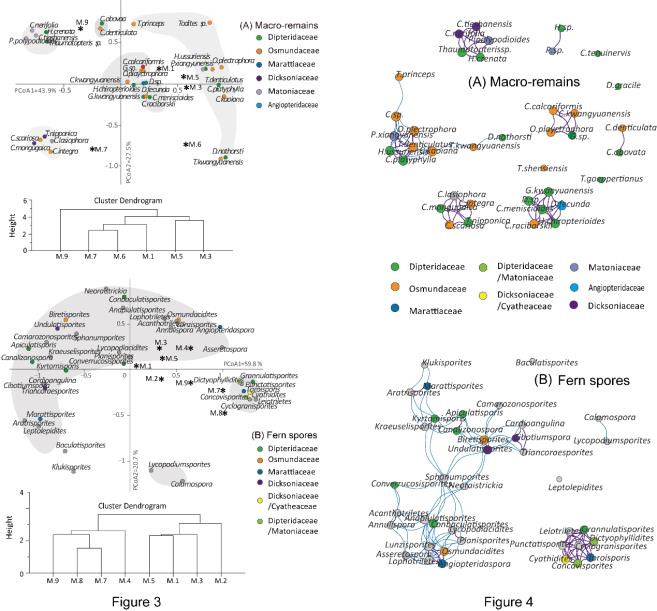A new report was recently published in the international journal Global and Planetary Change on the pattern of vegetation turnover during the end-Triassic mass extinction on the basis of fern communities from South China.
The end-Triassic mass extinction (ETME) is one of the five most severe extinction events in Earth history and caused the disappearance of ca. 80% of all species. The terrestrial ecosystems were also greatly affected by this extinction, but the severity of the land plant diversity loss is not well understood. Although compared with palynology data, plant macrofossils usually have a limited stratigraphic resolution, but tracked their species diversity and lived environment can provide a more intuitive and effective method for studying the extinction rate and evolution mode of terrestrial vegetation.
Recently, an international research team leading by Prof. WANG Yongdong from the Nanjing Institute of Geology and Palaeontology, Chinese Academy of Sciences (NIGPAS), Dr. ZHOU Ning, Prof. ZHANG Xingliang, from the Department of Geology of Northwest University, China and Prof. Wolfram Kürschner from Department of Geosciences, University of Oslo have investigated the diversity and ecology of fern during the Triassic-Jurassic (Tr–J) transition in the Sichuan Basin of South China and focused for the first time on the impact of the end-Triassic mass extinction event on the fern communities. The researchers collected fossil fern records, approximately 67 species ascribed to 16 genera of eight families, from 16 localities of the Rhaetian Xujiahe Formation to the lowermost Jurassic Zhenzhuchong Formation. The results indicate that a gradual decline at both the genus and species levels of macro-microflora of ferns at ETME with no obvious mass extinctions in the Sichuan Basin. However, the fern and palynological data show a clear vegetation turnover after the end-Triassic in the Sichuan Basin demonstrated that the response of vegetation changes in places far away from CAMP volcanism. The multivariate statistical approaches (principal coordinates analysis, cluster analysis, network analysis) for fern macro-remains and spores data infer a warm and humid climate during the Rhaetian. The significant increase of typical dry-resistant taxa across the Tr-J boundary, indicating a dryer environment at the earliest Jurassic.
This study was jointly supported by the Strategic Priority Research Program (B) of the Chinese Academy of Sciences, the National Natural Science Foundation of China, State Key Programme of Basic Research of Ministry of Science and Technology, China and SKLPS State Key Lab Funding of NIGPAS.
Reference: Ning Zhou, Yuanyuan Xu, Liqin Li, Ning Lu, Pengcheng An, Mihai Emilian Popa, Wolfram Michael Kürschner*, Xingliang Zhang, Yongdong Wang*, 2021. Pattern of vegetation turnover during the end-Triassic mass extinction: Trends of fern communities from South China with global context. Global and Planetary Change. Volume 205, October 2021, 103585. https://doi.org/10.1016/j.gloplacha.2021.103585.

The diversity changes of fern species during Triassic–Jurassic transition in the Sichuan Basin and the scatter diagrams illustrating the agreement between the fern macro-remains and spores in the northeastern Sichuan basin.

Left:Cluster dendrogram and PCoA biplots showing the diversity of (A) fern macro-remains (species level) and (B) fern spores (genera level) ; Right: Networks of co-occurring of (A) fern macro-remains (species level) and (B) fern spores (genera level) based on correlation analysis.

Sketch drawing of some fern species from the Upper Triassic in the Sichuan Basin
A. Dictyophyllum nilssoni;B. Marattia muensteri; C. Hausmannia emeiensis;D. Danaeopsis fecunda

Sketch drawing of some fern species from the Upper Triassic and Lower Jurassic in the Sichuan Basin
A. Coniopteris tiehshanensis;B. Todites kwangyuanensis;C. Cynepteris lasiophora;D. Phlebopteris xiangyuensis
LIU Yun, Propagandist
Email: yunliu@nigpas.ac.cn
Nanjing Institute of Geology and Palaeontology, Chinese Academy of Sciences
Nanjing, Jiangsu 210008, China
Download:
